Labour market report, June 2021
Employment in Ontario increased by 116,900 in June. Get the details in this report.
Quick facts
In June 2021:
- There were 12.3 million people in Ontario aged 15 years or older
- 8.0 million (64.7%) were in the labour force, including those who had worked, were unemployed and looking for work or did not work at their job, which includes people on temporary layoff because of ongoing COVID-related business closures. The labour force increased in June (52,700 or 0.7%) compared to May.
- 7.3 million (59.2%) were employed, up by 116,900 (1.6%) from May.
- Ontario's unemployment rate decreased to 8.4% in June from 9.3% in May and 668,800 people were unemployed, down 8.8% (-64,200) from May.
Important note:
This report is based on the Labour Force Survey (LFS), a household survey carried out by Statistics Canada. June’s LFS results covers labour market conditions as of the week of June 13 to 19.
Ontario’s mandatory closure of non-essential businesses and other measures aimed at addressing the impact of COVID‑19 took effect on March 24, 2020.
The province-wide Stay-at-Home order requiring everyone to remain at home except for essential purposes that took effect on April 8, 2021 ended on June 2, but most COVID‑19 health measures remained in place during the June LFS reference week.
Ontario moved to Stage 2 of the province’s reopening plan on June 30, which includes increased capacity limits for retail shopping and both indoor and outdoor gatherings, as well as the opening of malls and the resumption of some personal services.
The types of businesses that were deemed essential and remained open during the COVID‑19 economic shutdown and the types of businesses that reopened at the different stages of the Ontario government’s plan for reopening the economy should be considered in the context of information provided in this report.
Employment increased in June
Employment in Ontario increased by 116,900 (1.6%) in June, following consecutive declines in May (-31,600 or -0.4%) and April (-152,700 or 2.1%).
In June, employment in Ontario was 7,300,700 and 190,400 (-2.5%) below its pre-COVID-19 February 2020 level.
Chart 1 shows employment in Ontario from January 2005 to June 2021.
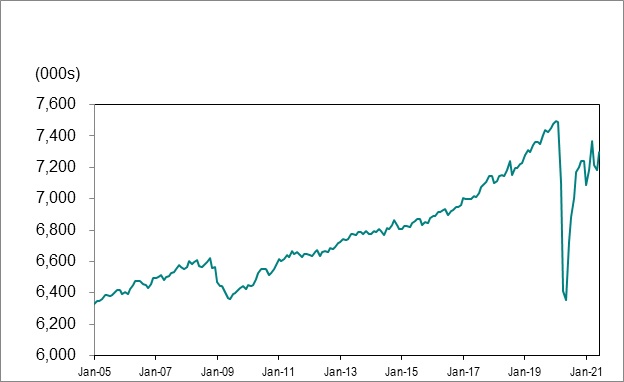
Source: Statistics Canada, Labour Force Survey, Table 14-10-0287-01, (seasonally adjusted data).
Full-time vs. part-time
Full-time jobs increased by 24,700 (0.4%) and part-time jobs increased by 92,200 (7.6%) in June.
Employment change by sex and age
June’s employment gain was 95,700 (2.8%) for women and 21,200 (0.6%) for men.
With June’s gains, employment among women was 2.6% (-90,600) below its pre-COVID February 2020 level and employment among men was 2.5% (-99,800) behind.
Youth employment (ages 15-24) increased by 85,700 (10.2%) in June, after declining by 23,000 (-2.7%) in May. Employment for people aged 25 to 54 increased by 20,000 (0.4%) in June, following an increase of 7,700 (0.2%) in May. Employment for those aged 55 and older grew by 11,100 (0.7%) in June, following a decrease of 16,200 (-1.0%) in May.
In June, youth employment remained further from pre-COVID February 2020 levels (-9.5% or -96,900) than employment among those aged 25-54 (-1.3% or -60,900) or those aged 55 and over (-1.9% or -32,600).
Employment in Canada increased by 230,700 (1.2%) in June after decreasing by 68,000 (0.4%) in May and was 340,400 (-1.8%) below its pre-COVID February 2020 level.
Employment change by industry
The government’s restrictions on the types of businesses that were deemed essential and other measures aimed at addressing the impact of COVID-19 should be considered in the context of employment change by sector.
In June, employment in accommodation and food services was furthest below its pre-COVID February 2020 level (-100,800 or -22.8%), followed by employment in wholesale and retail trade (-42,300 or -3.8%), business, building and other support services (-33,300 or -10.3%), construction (-32,100 or -6.0%) and transportation and warehousing (-25,400 or -6.4%).
Employment was furthest above pre-COVID February 2020 levels in professional, scientific and technical services (70,200 or 10.5%), public administration (22,900 or 5.9%), health care and social assistance (9,700 or 1.1%) and finance, insurance, real estate, rental and leasing (4,900 or 0.8%).
Chart 2 shows industries by employment change in Ontario, February 2020 to June 2021.
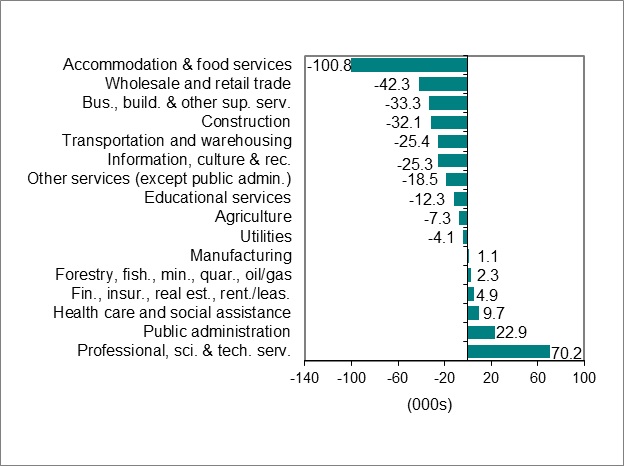
Source: Statistics Canada, Labour Force Survey, Table 14-10-0355-02, (seasonally adjusted data).
Unemployment rate decreased to 8.4%
Chart 3 shows unemployment rates, Ontario and Canada, January 2005 to June 2021.
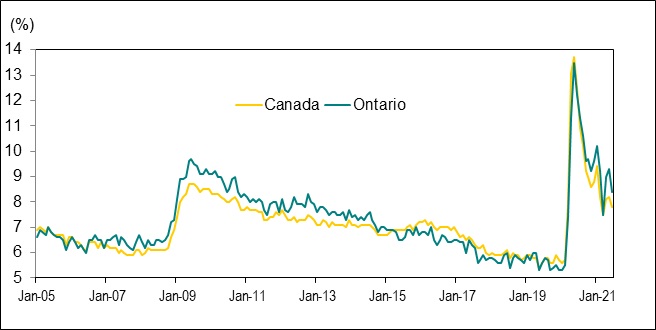
Source: Statistics Canada, Labour Force Survey, Table 14-10-0287-01, (seasonally adjusted data).
Ontario’s unemployment rate in June was 8.4%, down from 9.3% in May. The unemployment rate in February 2020 was 5.5%.
Canada’s unemployment rate fell to 7.8% in June, down from 8.2% in May. Canada’s unemployment rate in February 2020 was 5.7%.
Unemployment rate by sex and age
The unemployment rate for women was 7.9% in June, down from 9.4% in May, while the rate for men fell to 8.8% from 9.1% during the same period.
In Ontario, the unemployment rate among population groups designated as visible minorities was estimated at 11.0% in June in comparison to a 6.8% rate for non-visible minorities and those that did not identify as Indigenous (data are for the population aged 15 to 69 and are not adjusted for seasonality).
For individuals aged 15 to 24, the unemployment rate decreased to 17.2% in June from 20.7% in May. The youth unemployment rate reached a record high of 30.0% in June 2020.
The unemployment rate for individuals aged 25 to 54 was 6.5% in June, down from 7.0% in May, while the rate for those aged 55 and older decreased to 8.3% from 8.8%.
Long-term unemployment
In June, an average of 215,700 Ontarians or 32.3% of all unemployed people were unemployed for 27 weeks or longer (long-term unemployed). This was down from 218,800 in the previous month and three times the pre-COVID February 2020 level of 68,800.
The average time in unemployment increased to 26.7 weeks in June 2021 from 15.9 weeks in February 2020.
Chart 4 shows the number of people unemployed for 27 week or more in Ontario, January 2005 to June 2021.
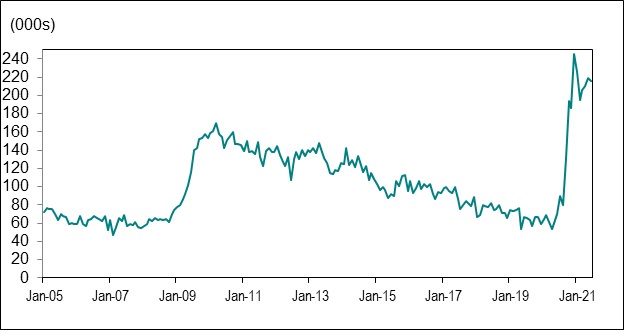
Source: Statistics Canada, Labour Force Survey, Table 14-10-0342-01, (seasonally adjusted data).
Employment and unemployment in urban centres
Employment change in urban centres
Chart 5 shows employment change for Ontario Census Metropolitan Areas (CMAs) from May 2021 to June 2021.
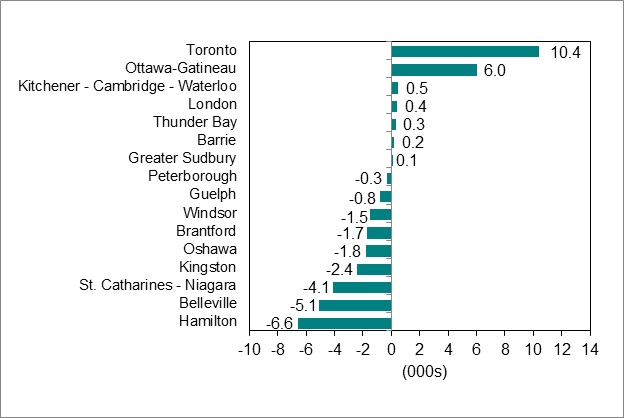
Source: Statistics Canada, Labour Force Survey, Table 14-10-0380-01, (seasonally adjusted data three-month moving average to reduce volatility caused by small sample size).
Toronto (10,400 or 0.3%) and Ottawa-Gatineau (6,000 or 1.0%) led employment gains among the sixteen Ontario Census Metropolitan Areas (CMAs) between May and June.
Employment levels fell in many of the sixteen CMAs between May and June, led by Hamilton (-6,600 or -1.6%), Belleville (5,100 or -10.6%), and St. Catharines-Niagara (-4,100 or -2.1%).
In June, employment in 11 of the 16 Ontario urban centres remained below pre-COVID February 2020 levels, led by Toronto (-168,100 or -4.9%), St. Catharines-Niagara (-17,000 or -8.2%), Oshawa (-15.200 or -7.2) and Belleville(-15,000 or -25.8%).
Ottawa-Gatineau (10,400 or 1.8%), London (8,300 or 3.1%), Peterborough (7,500 or 13.0%) and Guelph (3,300 or 3.8%) reported employment that was above pre-COVID February 2020 levels.
Lowest and highest unemployment rates in urban centres
Chart 6 shows Census Metropolitan Areas (CMAs) with highest and lowest unemployment rates in Canada, June 2021.
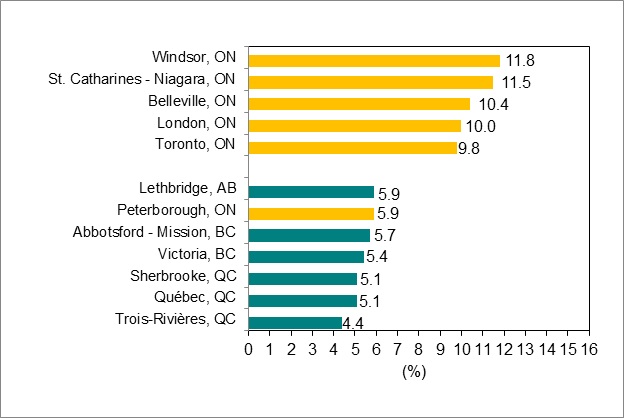
Source: Statistics Canada, Labour Force Survey, Table 14-10-0380-02, (seasonally adjusted data three-month moving average to reduce volatility caused by small sample size).
Ontario Census Metropolitan Areas (CMAs) recorded the highest unemployment rates in Canada in June, led by Windsor (11.8%) and followed by St. Catharines-Niagara (11.5%) and Belleville (10.4%).
Peterborough recorded the lowest unemployment rate in Ontario in June (5.9%), while Trois-Rivières recorded with the lowest unemployment rate in Canada (4.4%).
Download data
Source: Statistics Canada, Labour Force Survey
June 2021 Labour Market Report:
- CSV, Chart 1, employment in Ontario from January 2005 to June 2021, 1Kb
- CSV, Chart 2, industries with highest and lowest employment change in Ontario, February 2020 to June 2021, 2Kb
- CSV, Chart 3, unemployment rates, Ontario and Canada, January 2005 to June 2021, 2Kb
- CSV, Chart 4, number of people unemployed for 27 week or more in Ontario, January 2005 to June 2021, 2Kb
- CSV, Chart 5, employment change for Ontario Census Metropolitan Areas (CMAs) from May 2021 to June 2021, 2Kb
- CSV, Chart 6, Census Metropolitan Areas (CMAs) highest and lowest unemployment rates, June 2021, 2Kb